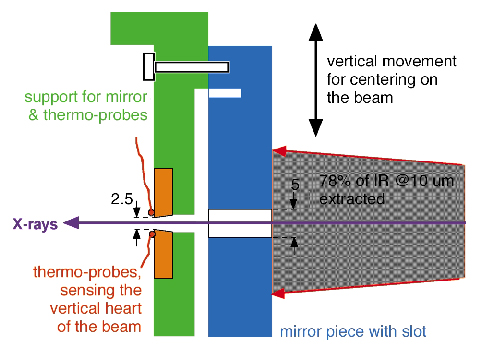Infrared Beamport
An Infrared beamport was constructed in a dedicated laboratory on ID21 during 2004. It is intended to be used for infrared microscopy and makes use of the high brightness of the so-called edge radiation produced when electrons enter a bending magnet. Whereas the ESRF would compete unfavourably with lower energy facilities to collect a high flux of infrared radiation, the need of high brightness for microscopy makes the edge radiation from the ESRF quite competitive.
A delicate engineering issue in designing this beamport is the collection of infrared by a mirror exposed to very high power bending magnet radiation. The water-cooling of such a mirror is a source of mechanical noise on the mirror and therefore on the reflected light which, from experience at other infrared beamlines in the world, must be minimized. As a result, it was decided to suppress the water-cooling of the mirror. This was made possible by opening a slot in the mirror and letting the hard X-ray pass through. The much wider vertical divergence of the infrared radiation is collected on both sides above and below the slot. This is illustrated in Figure 165. To allow for a slow drift of the closed orbit of the electron beam in the bending magnet and avoid overheating of the mirror, the vertical position of the mirror is remotely controlled and permanently driven in a closed loop by monitoring the temperature on two thermocouples located on both sides of a 2.5 mm aperture inside which the hard X-ray propagates (see Figure 165).
 |
|
Fig. 165: The vertically motorised slotted mirror M1 designed for collecting infrared radiation and avoiding thermal deformation. The hard radiation propagates through the slot while most of the infrared is reflected. |
Figure 166 presents the beamport layout including 7 mirrors. Another specificity of this infrared line is the use of a 37 mm diameter 0.8 mm thick CVD window located as upstream as possible. This window, which defines (and limits) the angular collection of the infrared radiation, is leak tight. It has been tested to both overpressure and accidental venting in the line; it isolates the ring vacuum from the beamline vacuum while staying transparent to the infrared. The whole line is operated in a low UHV type pressure which allows the use of ion pumps and facilitates the design of the vacuum protection.
 |
|
Fig. 166:Optics scheme of the extraction & transfer-line. |
The extracted light was recorded in the visible using a CCD camera located in front of M3, i.e. at the farthest distance possible from the source before any refocusing is applied. The image recorded in the visible part of the spectrum behind an interferential filter is shown in Figure 167a in good agreement with expectation from the SRW software [1] shown in Figure 167b. Both images show a ring-like structure that is produced by the interference of the fringe fields radiated by the electrons in the upstream and downstream bending magnets. Note that to perform such a measurements the slotted mirror M1 was lowered to a position where the whole of the visible light is collected, and to prevent any thermal deformation of M1 the ring current was limited to 1 mA.
A blackening on both the M1 surface and a quartz window (that was temporarily installed for a few months at the location of the CVD window location) was observed. Remedies are being sought with the possible use of Au or Ni coatings on M1, and/or by improving vacuum quality at this location.
 |
|
Fig. 167: Visible light pattern observed in the visible around 500 nm at the place of the M3 mirror. (a) Measurement; (b) Prediction from the SRW software. |
Reference
[1] SRW was developed at ESRF by O. Chubar and P. Elleaume. It is available for download from www.esrf.fr/Accelerators/Groups/InsertionDevices/Software/



